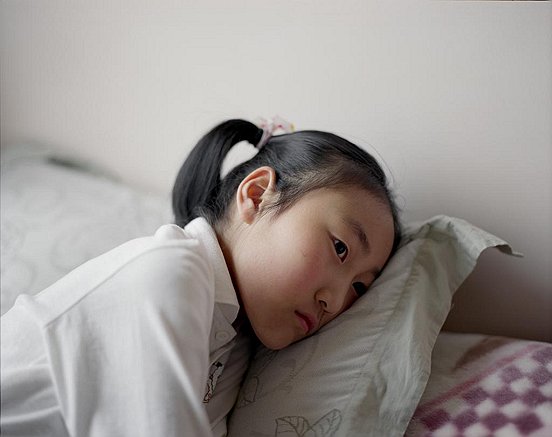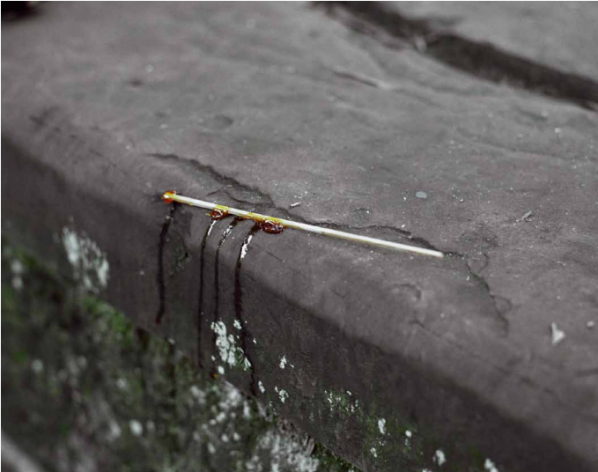
Shen Wei, "Ming", Shanghai, 2010, c-print, 40.6 × 50.8 cm
By Peter Hessler
“I never touched a camera before I went to America in 2000,” says Shen Wei. “In China there was not such a thing as fine art photography. You went to a gallery and it was all paintings. It was an abstract thing to me; I really knew nothing about the art world outside of China.” Shen grew up in an artistic family; in addition to his mother, both his aunt and uncle worked as artists. But after middle school, Shen enrolled in a vocational school that specialized in hotel services. He was assigned to the Blue Sky Hotel, where he worked as a waiter. It was his first experience of life outside of the old neighborhood. “The people who stayed there came from all over China,” he says. “I would look at them and wonder what kind of lives they had.” He hated working at the Blue Sky, but a manager noticed his artistic talent and had him design the boards that advertized the daily dinner specials. “Those assignments were an escape,” he says. “I’d do it as slowly as I could.”
After more than two years in hotel services, Shen attended Shanghai Light Industry College, where his specialty was packaging design. For a few years he worked as a freelancer, undertaking the motley assignments that were available in China during the late-1990s. “I designed a lot of catalogs for the police,” he says. “If the police came up with new regulations for shipping companies, they’d print ten thousand catalogs. I designed some of them.” He created posters for a Beijing Opera troupe. He designed shopping bags for the Peace Hotel. He worked for Coca-Cola and United Airlines. He created a set of drink coasters, each of which featured a map of Shanghai from a different decade – the 1920s, the 1930s, the 1940s; every time you moved your drink you saw a city transformed.

Shen Wei, "Swan", Xi’an Shananxi Province, 2009, c-print, 40.6 × 50.8 cm
The money was good, but the work never felt meaningful. “I did design as a job,” he says. “I didn’t put my soul into it.” In 2000, he enrolled at the Minneapolis College of Art and Design, where he hoped to become a painter. But his plans changed after he took a required introductory class in photography. “I took two photo classes, and I was so inspired by the medium that I decided I wanted to become a photographer.”
Over the next decade, Shen learned photography and established himself in New York City. He rarely returned to China, and he dedicated his efforts to a series of photographs that explored identity and sexuality in America. He eventually entitled that project Almost Naked, and in 2008 he returned to China and gave a lecture about his work at People’s University in Beijing. He found the experience profoundly disorienting. “It was very hard for me to explain things, especially photography, because I had learned everything in English,” he says. “I had a hard time explaining it in Chinese. And I was constantly getting lost in what I was seeing, because everything was new.”
Shen began making long trips to China, where he reconnected with the culture,? learning a new vocabulary that allowed him to describe his art. And he began to apply the photographic skills that he had learned in America to his homeland, taking portraits in provincial cities like Chengdu, Guilin, and Wuhan. He rarely photographed Shanghai and Beijing, because they were already so developed. In the nation’s interior, where the transformation wasn’t yet complete, he could still find traces of the China he remembered from childhood. “I started to look back to old things, to things I grew up with,” Shen says. “Things that at the time didn’t seem so important.”

Shen Wei, "Clock", 2009, c-print, 40.6 × 50.8xcm
There are almost no automobiles in this book. There aren’t any factories or assembly lines. We don’t see vast mobs of people, or overwhelming traffic scenes, or the army-like crews of uniformed workers that have become standard in the foreign imagery of today’s China. Instead, these are quiet, personal pictures, and they often have an early-morning feel, those hazy hours when Chinese people traditionally enjoy being outdoors. A large number of photographs feature the private side of public parks. Green is a common color. And water is everywhere – canals and rivers and lakes, the slate-gray surface a slightly deeper shade than the sky. There was a time when the life of Chinese cities revolved around waterways rather than roads, and it was recent enough that even a thirty-year-old photographer can recall it with nostalgia.
Often the people in these photographs are solitary. Many are strangers who agreed to pose for Shen as he passed through town, and he shot them in their homes and neighborhoods. In a number of pictures, an individual stands on the periphery of some expansive scene – a wintry park, a placid lake, a misty mountain. With these images, the sense of the past runs far deeper than a young man’s memory. It connects with the millennia-old tradition of Chinese landscape painting, where balance is perfect and tiny figures teeter at the edge of sweeping vistas. During Shen Wei’s years in America, living in Minneapolis and New York, he often recalled the Li Bai poem “Quiet Night Thoughts.” Written over a thousand years ago, the poem captures the author’s homesickness in twenty spare characters.

Shen Wei, "Sugar", Chongqing, 2009, c-print, 40.6x50.8cm
“Every time I think about this poem, I think about all those Chinese paintings of the Yellow Mountains, with the little people in the mountains,” Shen says. “It’s almost like a fantasy, to live in the ancient times. People living in the mountains living on the water, drinking wine and writing poetry. This is a kind of dream, my dream of life. I often think if there’s a dynasty in China I want to go back to, it’s the Tang dynasty.”
Before my bed there is bright moonlight So that it seems like frost on the ground: Lifting my head I watch the bright moon, Lowering my head I dream that I’m home. übersetzung aus dem Englischen Simone Schede? Der Autor und der Künstler The Author an the Artist
About the Artist
Shen Wei
Born 1977, Shanghai, China
Studied School of Visual Arts, New York and Minneapolis College of Art and Design
Lives and works in New York City and Shanghai
Collections (selection)
Museum of Modern Art, New York, NY
Philadelphia Museum of Art, Philadelphia, PA
J. Paul Getty Museum, Los Angeles, CA
Carnegie Museum of Art, Pittsburgh, PA
Museum of Contemporary Photography, Chicago, IL
Museum of Chinese in America, New York, NY
Museum of Fine Arts, St. Petersburg, FL
Library of Congress, Washington D.C.
Florida Museum of Photographic Arts, Tampa, FL
Griffin Museum of Photography, Winchester, MA
About the exhibition
Duration: 9. November—28. Dezember 2013
Venue: L.A.Galerie Lothar Albrecht, Domstra?e 6, D-60311 Frankfurt, Germany
Courtesy of the artist, for further information please visit http://lagallery-frankfurt.de.




























